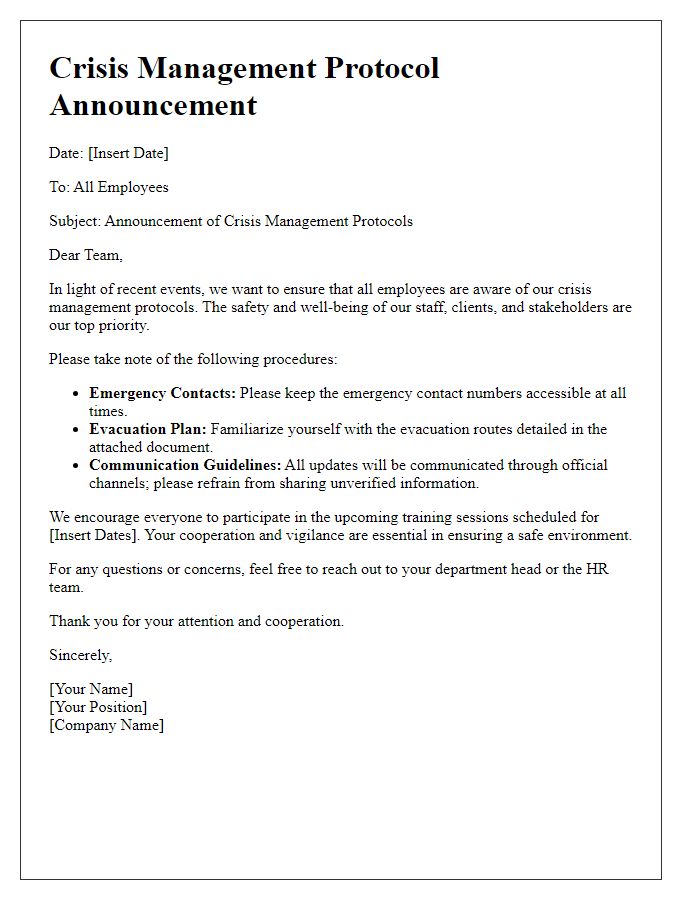In today's rapidly changing world, having a solid crisis management policy is essential for every organization. Whether facing natural disasters, public relations challenges, or unforeseen events, effective communication can make all the difference. A well-crafted letter can serve as a guiding tool, helping you outline your strategy and reassure stakeholders of your commitment to transparency and accountability. Ready to dive deeper into how you can create a comprehensive crisis management letter? Read on!

Clarity and Conciseness
Crisis management policies require clarity and conciseness to ensure effective communication during emergencies. Key elements include a clearly defined chain of command for decision-making, detailed emergency response procedures tailored to specific types of crises such as natural disasters, cybersecurity breaches, or public relations incidents. Contact information for essential team members, local emergency services, and relevant stakeholders must be included for swift communication. Timelines for response actions should be established to prevent delays. Regular training sessions and drills, which enhance preparedness, are essential aspects of the policy. A framework for post-crisis evaluation will aid in learning from the incident, improving future responses. Clear documentation and distribution of this policy ensure awareness among all employees, fostering a culture of readiness.
Stakeholder Identification
Stakeholder identification plays a crucial role in crisis management, significantly influencing the effectiveness of response strategies. Key stakeholders include internal groups like employees in various departments, such as Human Resources and Communications, who will manage internal communications and operational continuity. External stakeholders encompass customers, suppliers, regulatory bodies, and local communities, all of whom have vested interests in the organization's reputation and sustainability. For example, understanding the concerns of 2,000 local residents impacted by manufacturing operations is essential for maintaining trust. Furthermore, media outlets and social media platforms serve as key channels for information dissemination, which can shape public perception during a crisis. Engaging with these stakeholders, analyzing their needs, and determining their influence on crisis resolution are vital for fostering collaboration and ensuring transparent communication throughout the incident.
Communication Strategy
Crisis management policy communication strategy outlines essential procedures for disseminating information during emergencies. Key components include identifying stakeholders such as employees, clients, and media representatives. Communication channels, including press releases and social media platforms, must be established to ensure timely updates. Utilizing a designated crisis communication team, typically comprising public relations experts, ensures consistent messaging. Establishing a feedback loop allows stakeholders to report concerns or seek clarity. Regular training sessions for staff on crisis scenarios enhance readiness. Application of communication frameworks, like the SITUational Crisis Communication Theory (SCCT), aids in tailoring responses based on the nature of the crisis. Overall, proactive planning, clarity, and transparency are paramount for effective crisis management communication.
Roles and Responsibilities
Crisis management policies delineate essential roles and responsibilities to ensure effective response during unforeseen events. The Crisis Management Team (CMT), comprising representatives from key departments like Public Relations, Operations, and Human Resources, oversees the strategic implementation of the plan. The Public Relations Officer manages communication with stakeholders, ensuring timely and transparent updates about the crisis. The Operations Manager coordinates logistics, such as resource allocation and personnel safety, while ensuring business continuity. The Human Resources Manager addresses employee concerns, providing support and guidance during emergencies. Each team member must understand their specific duties and collaborate effectively to mitigate the impact of the crisis on the organization. Regular training sessions and simulations, occurring at least twice a year, enhance preparedness and refine response strategies for various crisis scenarios.
Review and Updates
A comprehensive crisis management policy requires regular review and updates to address emerging risks and changing organizational needs. Effective policies, like those implemented by Fortune 500 companies, should include a detailed action plan for various crises, such as natural disasters (hurricanes, earthquakes), data breaches (cybersecurity incidents), or public relations issues (product recalls). Stakeholders, including crisis management teams, legal advisors, and communication officers, should meet quarterly to assess existing protocols and incorporate lessons learned from recent events, such as the 2020 pandemic response. This iterative process ensures that response strategies remain relevant and effective, enabling organizations to maintain resilience and protect reputation during unexpected challenges. Periodic training and simulations, aimed at improving employee readiness and awareness, further strengthen the overall effectiveness of the crisis management framework.













Comments